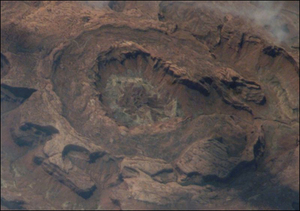One of the longest-running mysteries in the U.S. National Parks has been solved: The crater-like Upheaval Dome in Utah's Canyonlands National Park was caused by a meteor impact, say German researchers.

|
| ©USNP
|
| For decades geologists have debated whether Upheaval Dome in Utah's Canyonlands National Park, pictured here, was created by a volcanic outburst, an eruption of salt or a meteor impact. The crucial clue was the discovery there of "shocked quartz," which can be created only by the intense pressures of a violent meteor impact, say researchers.
|
For decades geologists have debated whether the picturesque "Sphinx of Geology," viewed by millions of park visitors, was created by a volcanic outburst, an eruption of salt or a meteor impact.
Then a crucial clue was discovered: "shocked quartz," which can be created only by the intense pressures of a violent meteor impact."This is great news because finally, after so many years of searching, the final clue that Upheaval Dome is an impact structure has been discovered," said impact crater researcher Christian Koeberl of the University of Vienna in Austria. "Their data are convincing."
The discovery was made by German researchers Elmar Buchner and Thomas Kenkmann, who published their findings in the March issue of the journal
Geology. Surprisingly, the shocked grains of quartz were located not at the center of the crater, but off to one side, suggesting that the meteor struck the Earth at an angle.
"Discovery of shock metamorphic features...is a requirement to 'nail' the impact origin of a feature, and they have done it," Koeberl told Discovery News.
In the 1930s, Upheaval Dome was interpreted as a volcanic feature by one geologist. Thirty years later, in the 1960s, another geologist proposed that it was the result of ancient sea salts buried under the rock. The salt, less dense than rock, rises up in the ground -- like a drop of oil rising up through water -- and buoys up the rock into a dome.
The meteor impact idea wasn't officially taken up by any researchers until the 1980s, and remained inconclusive until now.
"The very controversial debate about Upheaval Dome's origin has lasted nearly a century, over the course of which extremely different hypotheses (gradualism versus catastrophism) have been proposed," report Buchner and Kenkmann.
The debate has, in fact, reflected a historical divide of ideas in geology over those decades.
On one hand there were the "gradualists" who adhered to the idea that just about everything we see on the planet today is the result of gradual processes still at work -- glaciers moving, rains falling, rivers flowing, etc. Gradualism was considered heretical when it was proposed by James Hutton in the late 18th century because it implies the Earth was tremendously older than some Biblical scholars had claimed.
These Biblical scholars cited such catastrophes as Noah's flood to explain such geological oddities as marine fossils atop mountains.
These early "catastrophists" tended to ignore evidence that went against their Biblical interpretation of the geological record. In other words, they weren't very scientific.As a result, geologists are trained to tread very carefully wherever extraordinary events are being called on to explain geological features. The trouble is, of course, there are some things like Upheaval Dome, which are, as we now know, genuine creations of extraordinary -- albeit non-Biblical -- catastrophic events.
Reader Comments
to our Newsletter